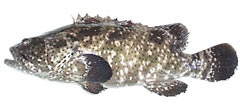Aquaculture production of estuary cod worth 120 million yen

Estuary cod, or mibai, a fish well known for its high-grade white flesh.
June 3, 2012 Maki Nagamine of Ryuyku Shimpo
Cultivation of estuary cod (mibai in the Okinawan dialect), a fish well known for its high-grade white flesh, has been steadily increasing. The production volume for fiscal 2010 exceeded 80 tons, the highest level to date, and the return on production has exceeded 100 million yen for the first time. The Okinawa Prefectural Government (OPG) is striving to increase the scale of the market outside Okinawa by developing techniques to transport live fish without using water. Targeting overseas countries that consume large quantities of estuary cod, the OPG intends to increase the production volume further in future.
When the cultivation of estuary cod began in fiscal 1997, the production volume was five tons, and the returns on production amounted to eight million yen. In fiscal 2000, as the number of producers increased, the production volume rapidly went up to 53 tons and the value of returns on production to 86 million yen.
While the production volume has been moving between 50 to 70 tons in recent years, the production volume soared to 88 tons and the production value to 120 million yen in fiscal 2010, both record highs. A representative of the OPG said, “We expect the production volume to exceed 90 tons this fiscal year.”
In 2010, the OPG developed a technique to keep cultivated estuary cod alive without water for about eight hours by soaking them in saltwater and inducing a state of suspended animation, making it possible to transport the fish alive. In fiscal 2011, the OPG budgeted 20 million yen to promote the market for transporting live estuary cod without water. The goal is to create employment for private distribution companies and to help expand markets outside of Okinawa.
The Kawaman Store Company of Urasoe, which was entrusted with the project, employed four people, and has promoted various events. In the 13th Japan International Seafood & Technology Expo held at Tokyo Big Sight last July, the company ran a booth introducing estuary cod. In October the same year at the Tsukiji Fish Market, otherwise known as the Tokyo Central Wholesale Market, the company invited 150 fish distributors and people involved in the catering industry to a tasting party in which they introduced estuary cod.
Kawaman president Kiyotaka Kawamitsu said, “I want to expand the market to Hong Kong where people eat estuary cod. The ones produced in Okinawa have a less fishy odor with better flesh compared with those produced in other countries. I would like to set the price relatively high and target upper to middle class customers.” While the shipping volume of estuary cod amounted to about ten tons in Okinawa in fiscal 2011, this year the company aims to ship about 16 tons outside Okinawa and about 23 tons overseas.
This fiscal year, the OPG intends to continue the project, for which it has budgeted about 10 million yen, and also to encourage private companies to expand the market overseas. Kazuhiko Shimada, the head of the Agriculture, Forestry and Fisheries Planning Division of the OPG, said, “There are still issues to resolve regarding the flesh of the estuary cod, and as we fix these step by step, we want to expand the production of estuary cod.”
(English translation by T&CT, Mark Ealey)
Previous Article:Shoji and Akira Yoshimi grow Okinawa pines in Kagoshima for the last 40 years
Next Article:Memorial for a Kamikaze pilot unveiled at Ogimi
[Similar Articles]
- New Year’s first auction at Tomari Fish Market in Naha
- Shipping volume of kariyushi shirts expected to exceed 400,000 items in 2013
- Okinawan sea grapes become a brand product
- JA Okinawa begins shipping citrus tankan Hayata to locations throughout the country
- Sugar production season kicks off in Okinawa
 Webcam(Kokusai Street)
Webcam(Kokusai Street)


